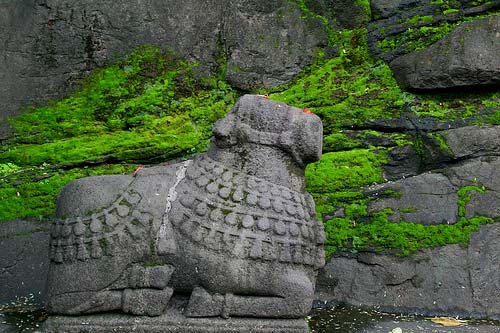Ellora Caves
Ellora caves |
About: |
|
The Ellora caves, locally known as ‘Verul Leni’ is located on the Aurangabad-Chalisgaon road at a distance of 30 km north-northwest of Aurangabad, the district headquarters. The Ellora caves is one of the World Heritage Sites in India. The Elora caves are one of the wonders of the time and speak volumes about the excellent craftsmanship of the Ellora artists, sculptors and painters. The structures at Ellora caves are not creation of a particular period but were built over a long period of time from the 6th century AD to 10th century. The structures at Ellora comprise of Buddhist, Hindu and Jain cave temples and monasteries. There are 34 caves at Ellora (12 Buddhist, 17 Hindu and 5 Jain caves) and they demonstrate the religious tolerance prevalent during this period of Indian history. The name Ellora itself inspires everyone as it represents one of the largest rock-hewn monastic-temple complexes in the entire world. Ellora is also world famous for the largest single monolithic excavation in the world, the great Kailasa (Cave 16).The Kailasa or Kailasanatha Temple, is the unrivaled centerpiece of Ellora. This gargantuan structure – designed to recall Mount Kailash, the abode of Lord Shiva – looks like a freestanding, multi-storeyed temple complex, but it was carved out of one single rock, and covers an area double the size of Parthenon in Athens. The caves are hewn out of the volcanic basaltic formation of Maharasthra, known as ‘Deccan Trap’, the term trap being of Scandinavian origin representing the step like formation of the volcanic deposits. The rock formation, on weathering has given rise to the appearance of terraces with flat summits.The hills in which the caves are hewn, forms part of the Sahyadri ranges of the Deccan and dated to the Cretaceous era of the Geological time scale (about 65 million years ago). The hills rise abruptly from the surrounding plains on the south and west, the western surface being extensively utilised for hewing the cave complexes. The hill also supports several streams, the prominent among them being the Elaganga, which drains into the Shiv, a stream of the Godavari river system. The Elaganga is in its full vigour during the monsoon, when the overflowing waters of a barrage in the upstream near Mahismati allows the gushing waters to land at “Sita-ki-nahani” near Cave 29 as a crashing waterfall. |
Location info: |
| Address: Aurangabad, Maharashtra,India. |
| District: Aurangabad district |
| Nearest City: Jalgaon |
| Best time to visit:October to March |
Climate/Weather: |
History: |
|
The Ellora Caves were built at time when Buddhism was declining in India and Hinduism was beginning to reassert itself. The Brahmanical movement was especially powerful under the patronage of the Chalukya and Rashtrakuta kings, who oversaw most of the work at Ellora - including the magnificent Kailasa Temple built in the 700s. The last period of building activity took place in the 10th century, when the local rulers switched allegiance from Shaivism (Hinduism devoted to Shiva) to the Digambara sect of Jainism. The coexistence of structures from three different religions serve as a splendid visual representation of the prevalent religious tolerance of India. For this reason and others, the Ellora Caves were designated a UNESCO World Heritage Site in 1983. http://en.wikipedia.org/wiki/Ellora |
Interesting things to do: |
| Explore the beauty of Ellora caves. |
Interesting things to Visit: |
|
Grishneshwar: Khuldabad: Daulatabad: |
Mobile range info: |
How to reach? |
| Nearest Railway Station: Jalgaon at a distance of around 60 km |
| Nearest Airport: Aurangabad domestic airport lies closest to the Ajanta caves and approximately 100 km away. |
| Road Transport: The Tourist Attractions in Ajanta Ellora Caves can be accessed via Aurangabad which is well connected to all neighbouring cities by state run buses. |
Nearest Visiting places: |
| 1.Ajanta Caves, Aurangabad 2.Elephanta Caves, Aurangabad 3.Gateway of India, Mumbai 4.Khajuraho Temples 5.Sanchi Stupa 6.Golconda Fort, Hyderabad 7.Jama Masjid, Hyderabad |
Nearest Petrol Pump: |
| Jalgaon |
Hotels/Lodge/Accommodation: |
| 1.Hotel Kailas. 2.Maharastra Tourism Development Corporation's Holiday Resort in nearby Fardapur. |
Things to carry: |
Tips & Suggestions: |
Help Line/Phone Number: |
| Police Station: 100 |
| Nearest Hospital: Available in Aurangabad. |
| Society/Community Phone Number |

.jpg)
.jpg)
.jpg)
.jpg)
.jpg)
.jpg)
.jpg)
.jpg)